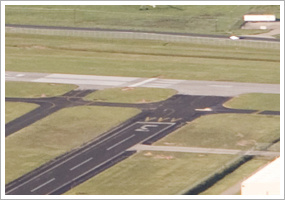| The following stories from the June 4, 2010, edition of AOPA ePilot were provided to AOPA members who expressed an interest in the particular subject areas. Any AOPA member can receive information tailored to their areas of interest by updating their preferences online. training tips Multiple-runway airports  It takes just a glance at an airport’s symbol on a sectional chart to get a sense of its layout and complexity or simplicity. Color is a clue: A blue symbol tells you there’s a control tower; magenta is for nontowered airports. Then there’s runway length: An airport with no runway longer than 8,069 feet is depicted within a colored circle. The circles vanish as runways lengthen. But there could be a catch: Airport symbols show “all recognizable runways, some which may be closed,” according to the Aeronautical Chart User’s Guide . “Many airports have two or more runways. There's typically one longer runway that faces into the historically prevailing wind, and a second so called crosswind runway that's used when the wind is blowing from an unusual direction. It's not uncommon to find that the crosswind runway is grass, while only the main runway and taxiways are paved. In other cases, the larger runway serves airline traffic, while the smaller runway serves general aviation (GA) operations,” explains the article “How it all works” on the Flight Training website. Multiple-runway airports present a variety of planning considerations to pilots. If your home base is a simple one-runway field, the more experience you can get coming and going at more complex airfields, the better. Visualizing multiple traffic patterns, and being able to change your plans on short notice, is one skill using such airports (especially towered) will teach you. Being alert to runway incursions and collision avoidance—crucial training concepts—takes on immediacy when the runway you’re using crosses other runways. See the AOPA Air Safety Foundation’s “ Anatomy of a Runway Incursion,” which includes an animation recreating a particular event of that type. Then click the link to take the foundation’s Runway Safety online course. Remember, even at a nontowered airport, more than one runway may be active. Know its convergence points and taxi routes. Check how much of any runway with a displaced threshold is available for landing. Will it bring you close to an intersection? A good example of displaced thresholds and intersecting runways appears in the satellite photo of the Orange, Mass., airport in AOPA Airports. Researching your destinations carefully tells you whether what you see is what you get! training products ASA Aviation Dictionary application If you’ve ever wondered what an aviation term meant and didn’t know how to find it, try ASA’s Aviation Dictionary application for iPhone, iPad, and iPod Touch. The application contains 10,000 terms and 500 illustrations to help you sort through the confusion. It costs $9.99, and is available at the iTunes App Store. Note: Products listed have not been evaluated by ePilot editors unless otherwise noted. AOPA assumes no responsibility for products or services listed or for claims or actions by manufacturers or vendors. final exam Question: I’m just starting to work on my instrument rating, and I’m curious about how to do precision approaches. I’ve talked with my flight instructor briefly about the localizer and glideslope needles and how to interpret what they display. What are the technical names for the needles? Answer: The needle that swings left and right is called a course deviation indicator (CDI). It receives signals from a localizer antenna that is located beyond the end of the runway to which you are doing the approach. The localizer provides the aircraft with lateral guidance to the runway. The needle that shows the aircraft’s vertical profile (glideslope) is the vertical deviation indicator (VDI). It receives information from a glideslope transmitter usually located off to the side near the approach end of the runway. It will provide the aircraft with adequate clearance over the threshold as well as any objects or terrain on the approach path. Got a question for our technical services staff? E-mail [email protected] or call the Pilot Information Center, 800/872-2672. Don’t forget the online archive of “Final Exam” questions and answers, searchable by keyword or topic. | 


